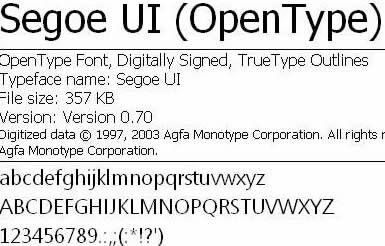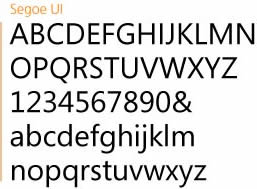home | fonts | articles | tips | newsletter | about
A Second Helping
The Two Ms Do It Again
Meet Segoe!

This young chap is all fresh and clear and straight to the point. Perfectly round curves, straight and sharp posture, delicately built colour and contrast. And hinted to kill to top off the proportional perfection. Beautiful. One could never ask for a more beautiful baby from any type design company. This guy is so handsome he is fit for friendly airport signage in a city known for its artistic vision and high standards, even fit for signs on highways where speed limits do not exist. Ooops. Alas, Segoe doesn't get to go that far. He merely ships with the next version of Windows, now in beta stages, code-named Longhorn and slated for public release in 2005 or 2006.
Segoe is the kind of font that deserves an extensive review with long poetic prose about its beauty. Too bad it already received a million reviews, has been on a million marketing pamphlets, was and is used all over the place. Yes, long before it was born, it was used everywhere. In fact, Segoe is not Segoe. It's the ghost, if living entities can have ghosts, of a typeface designed by Adrian Frutiger in the 1970s and released for public consumption in the 1980s.


Ghosts of living entities are usually not a problem in a field that always thrived on people "inspiring" each other in most amusing ways. Frutiger's typeface has become a veritable proverb in seeing ghosts of itself. Adrian Frutiger must be either furious or extremely flattered to have seen things like Humanist 777, Myriad, FF Tansit, Vera, and a slew of other ghosts see the light of day and become standard desktop publishing issue.
So we have another knockoff of Frutiger. Big deal!
Nice try, but not quite. Segoe is a special case that deserves a write-up, if only because of the players involved. Segoe comes from a foundry that has specialized, and evidently continues to do so, in knocking off Linotype designers over the years. Segoe will ship with the operating system of a company that also over the years specialized, and apparently continues to do so, in using Linotype fonts that are not quite Linotype fonts. Segoe, in short, is the third strike for Microsoft. The first strike was Arial, a font very similar to Helvetica - so darn similar the stroke widths, proportions and metrics are identical. Arial shipped and continues to ship with Microsoft Windows. The second strike was of course Book Antiqua, the sensationally scandalous Palatino clone that shipped and still ships with Microsoft Office. Arial and Book Antiqua were made by Monotype for Microsoft. Take a wild guess on who made Segoe for Microsoft now?
Alright, so history repeats itself, and the big fish eats the little fish. So what's new?
Well, hold on a moment there, eager space cadet. There is a central question to all of this. Segoe will not rest until he knows his raison d'Ítre, so to speak. We have to ask ourselves why Microsoft would go for strike three. It's really baffling. You can say whatever you want about Microsoft, but they did make amends with Zapf about Book Antiqua. Well, they did license Linotype Palatino later on, that is, but Book Antiqua still ships with MS Office and sells at AgfaMonotype's font retail site. The Arial/Helvetica story is another issue altogether, but let's leave it at that Max Miedinger is dead and no amends Microsoft or Monotype can ever make will bring him back.
The case of Book Antiqua ranks high on the amusement scale of type stories. To an outsider, that is, but certainly not to Hermann Zapf. A decade ago, Zapf fumed out of a type conference where his mid-century letters were being showcased as brand new design. He left the conference, resigned as the head of its organizing committee, and went straight to a well-known cloning house and knocked off his own design for them. This was unprecedented, and much more poignant than trying the legal bungee jump with Monotype and Microsoft.
This was years ago, but the Book Antiqua story lives on. Many years went by since the initial atrocity happened, and a lot of fast-paced type history took place. Mergers, acquisitions, demises, redemptions, new technologies, etc. Monotype and ITC were swallowed by Agfa, and so was the ICG library. Berthold has become an American Midwest litigious lizard sitting on exclusive fonts like eggs that can't hatch for centuries. Scangraphics and Font Company are no more. Adobe gave up on multiple masters, completely switched gears on computer platforms, and reduced their type output to a font set a year. Bitstream rose from the dead and opened a fonts 7-Eleven that continues to show losses after 14 quarters in existence. Linotype is beating the pulp of everything their library contains and swelling it up to enormous font families. Fonthaus went through a gazillion name changes and is now back to Fonthaus. Precision Type is in some kind of coma. The noblest subject one can now converse about in type design compounds is the "independent designer". Programmers have entered the type design equation full-force now with Open Type, and type designers are baffled as to how they're supposed to design 1000 letters and pay a programmer to develop the font, yet get paid the same amount they charged for 220 with no overhead. The words "revival" and "based on" and "inspired by" are still as misconstrued as ever. Overall, the entertainment gauge in type design keeps sliding back from green amusement to brown tragedy - except for the fact that now most cheap knockoff joints are in Europe, where design has more value, and where ironically fonts are said to have more protection.
But still, long after the bleaching and deep-cleansing of the black splotches squirted on type design's ever-grey burlap dress by names like SSI and SWFTE, the Book Antiqua story seeps into the air whenever the subject of knockoffs is at hand - which is quite often in a field where the ceiling of creativity has always been so necessarily constrained and technological importance universally sidelined.
So for years Book Antiqua was yet another focal point in maligning Microsoft. But eventually Microsoft paid the piper. They acknowledged that they shouldn't have used the Palatino clone, and they certainly made some amends. A few years after the Book Antiqua bundling with MS Office, Microsoft actually made a deal with Linotype (and subsequently Zapf) to license a legitimate copy of Palatino for shipping with Windows. That was good. Book Antiqua still ships with Office, and Arial still ships with Windows, but at least Palatino was properly licensed at last. Microsoft didn't really have to do that, but they went ahead and did it anyhow. It was a nice gesture. Too bad nice gestures end up meaning things to people, especially when the gestures are made by software mega-entities. When the legitimate licensing of Palatino took place, the Microsoft Typography people and their supporters (read suppliers) began some serious patting on Microsoft's back. Every time someone spoke of Book Antiqua, the reply became that amends were made, let sleeping dogs lie. Certainly, sir... after all, who am I to judge you when you have judged yourself and paid for redemption? Great. Looks like a clean slate. Kudos.
But redemption can very easily turn into a case of cry-wolf, like what is happening now. Then we fall in the same pit we dug years ago, and we knock off another great Linotype designer. Segoe oh Segoe! This will be the straw for Microsoft in type compounds. Will we ever be able to again believe that Microsoft gives the slightest damn about type designers? Don't know anymore. Credibility is a variable, but action speaks louder than a million words.
The question is this: why? Why would Microsoft want to use a Frutiger clone? Three years ago, they actually had a superbly hinted Frutiger, licensed legitimately from Linotype to ship with their Microsoft Reader software. Microsoft Reader was a free download, and in all likelihood millions of copies were downloaded. So why not just extend the licensing of something they already had instead of having to resort to the old treachery again? Especially after considerable effort and money were spent to repair the bridge with Linotype.
Could it be that Linotype's licensing arrangements for bundling are brutal and costly? This is not likely. Apple, a mere pauper in financial terms compared to Microsoft, recently licensed a load of fonts from Linotype - some really unnecessary fonts too - so if Apple can do it properly, why not Microsoft?
Could it be that Segoe is just a marker in the beta version of Longhorn, placed there until a licensing agreement has been finalized with Linotype? Also not likely. Segoe is at version 0.7 and already contains tons of glyphs on the Unicode map. This thing is growing like it's there to stay.
Could it be, and I must admit this is far-fetched, that Microsoft doesn't really know that Segoe is a Frutiger clone? Well, perhaps... Microsoft Typography hasn't been the sharpest tool in the shed since Robert Norton passed away. But still, the Apple Font Group hasn't been the sharpest tool in the shed since Dave Opstad retired, yet they still manage to avoid clones in what they ship with their OS and software (with the rare recent possible exception of Chalkboard). Also, one can imagine two or three Microsoft Typography hot-heads who don't know what's what, but that department certainly employs people like Paul Nelson, who is passionate enough about type to recognize things for what they are. So, another unlikely scenario.
Well, let's look on the bright side. Silver lining and all that. Adrian Frutiger can now know for sure that Frutiger has become a classic. In type design, classics are things that are copied over and over again. Garamond, Bodoni, Baskerville, Didot, Caslon, Jenson, Akzidenz, Franklin, Times, Palatino. A high and mighty list to belong to, if you ask me. Frutiger, under any other name (Myriad, Transit, Vera, Segoe, etc.) has certainly been taken for a ride enough times to actually belong to the high and mighty list.
Sign him up!
Fredrick Nader
December 2, 2003
Toronto
